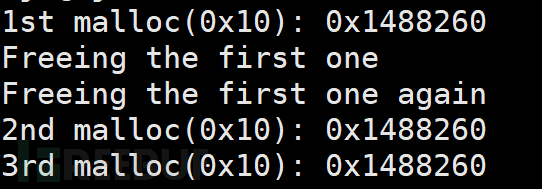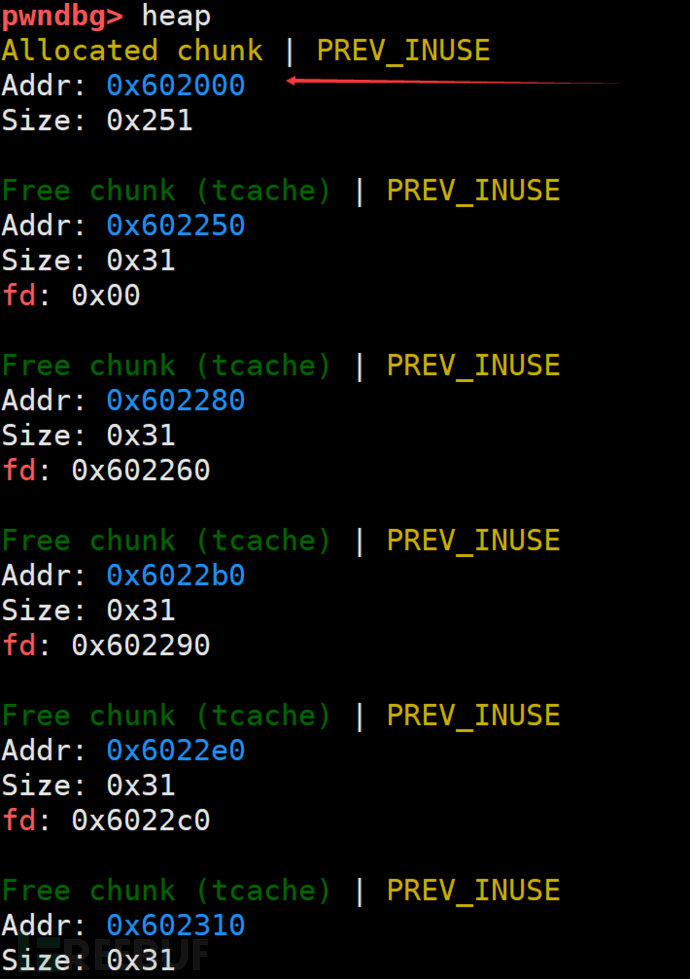在glibc2.26版本以后,出现了一个新的bin被称为TcacheBin,本文将详细的讲解一下TcacheBin的相关知识以及漏洞利用
TcacheBin相关代码
相关的宏
#if USE_TCACHE
/* We want 64 entries. This is an arbitrary limit, which tunables can reduce. */
# define TCACHE_MAX_BINS 64
# define MAX_TCACHE_SIZE tidx2usize (TCACHE_MAX_BINS-1)
/* Only used to pre-fill the tunables. */
# define tidx2usize(idx) (((size_t) idx) * MALLOC_ALIGNMENT + MINSIZE - SIZE_SZ)
/* When "x" is from chunksize(). */
# define csize2tidx(x) (((x) - MINSIZE + MALLOC_ALIGNMENT - 1) / MALLOC_ALIGNMENT)
/* When "x" is a user-provided size. */
# define usize2tidx(x) csize2tidx (request2size (x))
/* With rounding and alignment, the bins are...
idx 0 bytes 0..24 (64-bit) or 0..12 (32-bit)
idx 1 bytes 25..40 or 13..20
idx 2 bytes 41..56 or 21..28
etc. */
/* This is another arbitrary limit, which tunables can change. Each
tcache bin will hold at most this number of chunks. */
# define TCACHE_FILL_COUNT 7
#endif
宏比较多,可以直接从glibc中进行查看。简单来说就是glibc为每个线程都分配了一个TcacheBin,并且bin数组为64个,每个bin最多可以存放7个chunk。在32位系统中,bin会存放12-512字节的chunk,在64位系统中bin会存放24-1032字节的chunk。也就是说符合这些大小的chunk被释放后不会先加入fastbin,而是会先放入TcacheBin中。
声明的结构体
/* We overlay this structure on the user-data portion of a chunk when
the chunk is stored in the per-thread cache. */
typedef struct tcache_entry
{
struct tcache_entry *next;
} tcache_entry;
/* There is one of these for each thread, which contains the
per-thread cache (hence "tcache_perthread_struct"). Keeping
overall size low is mildly important. Note that COUNTS and ENTRIES
are redundant (we could have just counted the linked list each
time), this is for performance reasons. */
typedef struct tcache_perthread_struct
{
char counts[TCACHE_MAX_BINS];
tcache_entry *entries[TCACHE_MAX_BINS];
} tcache_perthread_struct;
static __thread tcache_perthread_struct *tcache = NULL;
TcacheBin新定义了两个结构体,第一个结构体里面存入一个指针,该指针指向下一个chunk。重点在第二个结构体,第二个结构体中有两个数组,其中第一个数组存放的是每一个bin链表有多少chunk,第二个则是每个bin数组中的内容存放fd指针,指向下一个chunk,并且TcacheBin以单链表构成,每个chunk的fd指针指向下一个chunk的fd字段。![AIO))L]MK_)G@DH45ZZ~6%R.png](https://image.3001.net/images/20211014/1634191983_6167ca6f9e8697636b538.png!small)
什么时候会用到TcacheBin
**free:**在释放chunk的时候,如果chunk符合Tcachebin的大小,并且该bin还没有被装满(没有七个),则会优先放入TcacheBin中
malloc:
当我们使用malloc的时候,返回一个chunk,并且该chunk是从fastbin中返回的,那么该chunk所对应下标的所有chunk都会被放入TcacheBin(当然,前提是Tcachebin没有被装满),而且由于fastbin和Tcachebin都是先进后出,所以就会导致chunk在移动完以后chunk的顺序和fastbin中的顺序相反。
smallbin中的也一样,返回的一个chunk属于smallbin,那么smallbin中对应的chunk就会全部放入Tcachebin(前提是没有装满)
当出现堆块的合并等其它情况的时候,每一个符合条件的chunk都会优先放入TcacheBin中,而不是直接返回(除非Tcache已满)。寻找结束后Tcache会返回其中一个
比较重要的一点,当我们调用malloc的时候,其实是先调用libc_malloc然后调用int_malloc,但是如果我们请求的大小在Tcachebin中有符合的chunk那么就会在libc_malloc中返回该chunk,而不会调用int_malloc
我们在处理chunk的过程中,如果在Tcache中的chunk已满,那么会直接返回最后一个chunk;binning code 结束后,如果没有直接返回(如上),那么如果有至少一个符合要求的 chunk 被找到,则返回最后一个。
tcache 中的 chunk 不会被合并,无论是相邻 chunk,还是 chunk 和 top chunk。因为这些 chunk 会被标记为 inuse。
TcacheBin的检查机制
/* Caller must ensure that we know tc_idx is valid and there's room
for more chunks. */
static __always_inline void
tcache_put (mchunkptr chunk, size_t tc_idx)
{
tcache_entry *e = (tcache_entry *) chunk2mem (chunk);
assert (tc_idx < TCACHE_MAX_BINS);
e->next = tcache->entries[tc_idx];
tcache->entries[tc_idx] = e;
++(tcache->counts[tc_idx]);
}
/* Caller must ensure that we know tc_idx is valid and there's
available chunks to remove. */
static __always_inline void *
tcache_get (size_t tc_idx)
{
tcache_entry *e = tcache->entries[tc_idx];
assert (tc_idx < TCACHE_MAX_BINS);
assert (tcache->entries[tc_idx] > 0);
tcache->entries[tc_idx] = e->next;
--(tcache->counts[tc_idx]);
return (void *) e;
}
这两个函数是TcacheBin取出和放入chunk,这两个函数基本决定了Tcachebin的检查机制非常简陋,甚至比fastbin还要简陋,所以很多漏洞我们都可以使用。我们可以看到glibc只对tc_idx做了一些检查,于是我们可以利用很多漏洞
Double Free
我们知道fastbin中为了防止double free,glibc只在其头部进行了检查,而在tcachebin中连检查都没有。我们可以直接连续两次释放。
#include <stdlib.h>
#include <stdio.h>
int main() {
void *p1 = malloc(0x10);
fprintf(stderr, "1st malloc(0x10): %p\n", p1);
fprintf(stderr, "Freeing the first one\n");
free(p1);
fprintf(stderr, "Freeing the first one again\n");
free(p1);
fprintf(stderr, "2nd malloc(0x10): %p\n", malloc(0x10));
fprintf(stderr, "3rd malloc(0x10): %p\n", malloc(0x10));
}
然后我们看一下输出结果 其原理和fastbin一样,也是形成环然后可以无限申请
其原理和fastbin一样,也是形成环然后可以无限申请
绕过Tcache
如果程序在编写的时候对Tcache进行了一些保护,需要我们绕过Tcache,那么此时我们应该怎么做呢?
此时有两种思路,首先是填满Tcache,填满以后再次进行malloc释放以后就会进入fastbin
#include <stdio.h>
#include <stdlib.h>
int main(){
int *p[7];
for(int i = 0;i<=7;i++){
p[i] = malloc(0x20);
}
for(int i = 0;i<=7;i++)
free(p[i]);
int *a = malloc(0x20);
free(a);
return 0;
}
程序运行后将会填满Tcache,然后再次释放就会释放到fastbin中。释放到smallbin中同理。
第二种思路就是尝试找到结构体,直接更改结构体内的chunk数。当我们遇到限制创建chunk时,例如用户只能创建5个chunk,大小都为fastbin的大小,此时我们想要绕过就只能通过更改结构体了。当我们开辟堆空间的时候,Tcache结构体的空间也将会被开辟在堆 我们完全可以进行篡改,例如我们可以把记录chunk个数的地方改为-1,由于定义的时候是无符号整数,所以如果被改为-1其结果就是变得非常大。然后我们就可以成功绕过Tcache。
我们完全可以进行篡改,例如我们可以把记录chunk个数的地方改为-1,由于定义的时候是无符号整数,所以如果被改为-1其结果就是变得非常大。然后我们就可以成功绕过Tcache。
其实TcacheBin还有好多漏洞都可以进行利用,可以在smallbin和fastbin进行利用的方式基本都可以在Tcachebin中使用。在glibc2.29版本中,给Tcache新增了一些检查,这个大家可以自行了解一下





